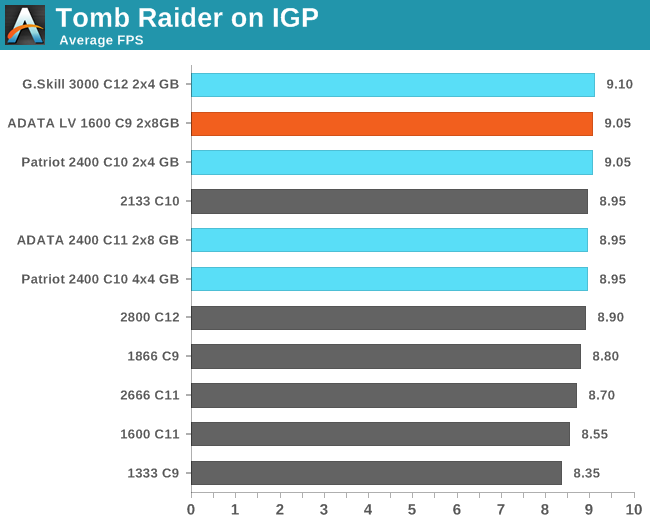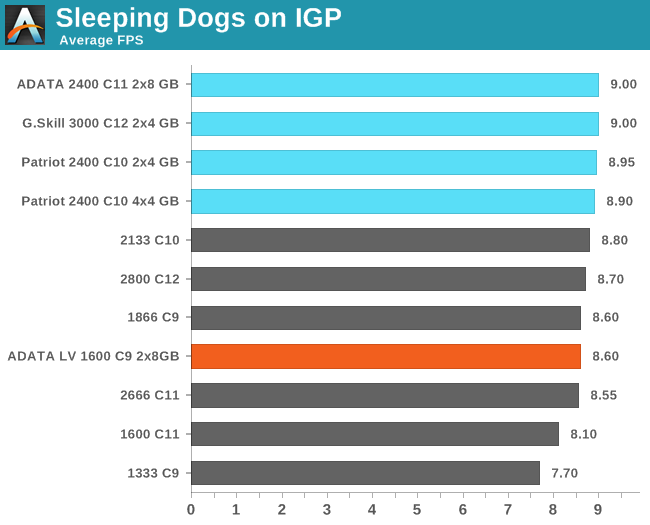ADATA XPG V1.0 Low Voltage Review: 2x8 GB at DDR3L-1600 9-11-9 1.35 V
by Ian Cutress on December 6, 2013 2:00 PM ESTIGP Gaming
The activity cited most often for improved memory speeds is IGP gaming, and as shown in both of our tests of Crystalwell (4950HQ in CRB, 4750HQ in Clevo W740SU), Intel’s version of Haswell with the 128MB of L4 cache, having big and fast memory seems to help in almost all scenarios, especially when there is access to more and more compute units. In order to pinpoint where exactly the memory helps, we are reporting both average and minimum frame rates from the benchmarks, using the latest Intel drivers available. All benchmarks are also run at 1360x768 due to monitor limitations (and produces more relevant frame rate numbers).
Bioshock Infinite:

Tomb Raider:

Sleeping Dogs:











35 Comments
View All Comments
Khenglish - Friday, December 6, 2013 - link
They do. It just costs more. Tons of 1600 9-9-9 T1 1.35V 8GB sticks on newegg. Even 1866 10-10-10 T1 8GB sticks.The question is if your laptop supports 1.35V or not. Only 8 series and a few 7 series laptops will run at 1.35V. Other laptops will run the memory at 1.5V despite it being 1.35V, which is fun if your laptop allows overclocking (which unfortunately is just top end clevo and alienware), but a waste of money and power if not.
jeffbui - Saturday, December 7, 2013 - link
Apple uses DDR3L in their Macbook Pros and LPDDR3 in their Air lineXpl1c1t - Friday, December 6, 2013 - link
Fail to see why this is something worth reviewing. Maybe in the 2009/2010 timeframe this would have been more relevant, but there were better performing kits available then @ 1.35v. Namely there were the GSkill ECO and Mushkin 996825 kits which were killer. I still run mine at 1700mhz 6-8-6-24-1T and 1.4v and am sure they could run well below 1.35v @ 1600.StrangerGuy - Saturday, December 7, 2013 - link
The more pressing question is the TOTAL lack of power consumption tests especially for standby states. C'mon who do you think the target customers are for low voltage RAM?MrSpadge - Sunday, December 8, 2013 - link
Those were probably 4 GB, or maybe even 2 GB modules.jeffrey - Saturday, December 7, 2013 - link
Ian Cutress,Hello! You keep writing articles about 1866/C9 being the minimum and to avoid 1600. Even going so far as to say, "Any kit 1600 MHz or less is usually bad news."
However, this ignores 1600/C8 modules. The 1600/C8 score a 200 on your Performance Index at stock timings. This is at your recommended 200 level. There are several kits of 2x4 GB 1600/C8 on Newegg that have memory profiles of 8-8-8-24 at 1.5v. I'll repeat, these 1600 8-8-8-24 1.5v kits score 200 on the Performance Index and hit the current memory sweet spot for most people of 2x4 GB. This scores within around 3% of the 1866/C9 kits which have a Performance score of 207.
The reason I bring this up is that the 1600 8-8-8-24 kits are often less expensive than the 1866/C9 kits and offer essentially all of the performance.
I enjoy reading your articles and appreciate the volume that you have contributed lately!
Hairs_ - Saturday, December 7, 2013 - link
if you look at the benchmarks for these articles, you'll see that the differences between any of the kits tested is either hairline marginal, within the boundaries of statistical error, or non existent with the exception of two tests: winrar 4.2 (and not earlier versions) and explicit solver. Since I doubt anyone is doing explicit solver on an Intel integrated graphics rig, and most people aren't using winrar, it's pretty clear that recommending anything other than a standard 1600 kit with decent timings is a waste of effort on Intel chips.However this appears to have slipped past anandtech's reviewers, so these meaningless articles continue.
GTVic - Saturday, December 7, 2013 - link
That didn't make any sense. The benchmark tool gives a performance index. Whether people use the software is irrelevant.Hairs_ - Sunday, December 8, 2013 - link
it's entirely relevant. It proves that with the exception of two very specific and rare use cases, these ram kits make no difference to much cheaper ones.ibemerson - Saturday, December 7, 2013 - link
The reason I have mostly seen given for using low voltage memory is that it will supposedly last longer, and enable CPU's with on-die memory controllers to last longer, especially since Intel specifies 1.5v for memory, while many kits run at 1.65v. Some of us want computers that keep working for 10+ years.One question I had when researching a possible X-79 build involves the fact that installing 8 sticks of RAM on a board will cause the on-die memory controller to auto-downclock the memory because of the increased load. Does low voltage ram avoid this?